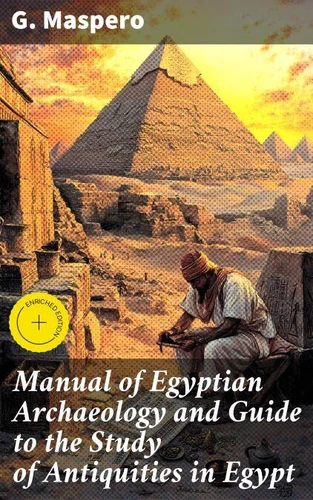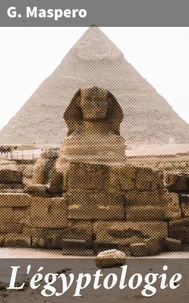Manual of Egyptian Archaeology and Guide to the Study of Antiquities in Egypt. Enriched edition. Unveiling the Mysteries of Ancient Egypt
Par : , ,Formats :
Disponible dans votre compte client Decitre ou Furet du Nord dès validation de votre commande. Le format ePub est :
- Compatible avec une lecture sur My Vivlio (smartphone, tablette, ordinateur)
- Compatible avec une lecture sur liseuses Vivlio
- Pour les liseuses autres que Vivlio, vous devez utiliser le logiciel Adobe Digital Edition. Non compatible avec la lecture sur les liseuses Kindle, Remarkable et Sony
 , qui est-ce ?
, qui est-ce ?Notre partenaire de plateforme de lecture numérique où vous retrouverez l'ensemble de vos ebooks gratuitement
Pour en savoir plus sur nos ebooks, consultez notre aide en ligne ici
- Nombre de pages2936
- FormatePub
- ISBN4057664189974
- EAN4057664189974
- Date de parution20/11/2019
- Protection num.Digital Watermarking
- Taille4 Mo
- Infos supplémentairesepub
- ÉditeurGOOD PRESS
Résumé
In "Manual of Egyptian Archaeology and Guide to the Study of Antiquities in Egypt, " G. Maspero embarks on an exhaustive exploration of ancient Egypt's rich archaeological heritage. Employing a meticulous and systematic literary style, Maspero presents a comprehensive analysis of artifacts, monumental structures, and daily life in ancient civilizations. His work is not merely a catalog of historical data; rather, it synthesizes archaeological findings with insightful interpretations that illuminate the cultural and social dynamics of the time.
Set against the backdrop of the late 19th-century Egyptology, the book serves as a foundational text for both scholars and enthusiasts, exemplifying the era's burgeoning interest in ancient history and archaeology. Gaston Maspero, a distinguished French Egyptologist and archaeologist, was instrumental in bringing Egyptian history to a wider audience. His tenure as the Director of the Egyptian Antiquities Service and his pivotal role in excavations and research in Egypt solidified his authority in the field.
Maspero's direct engagement with ancient sites and artifacts deeply informed his writing, allowing him to provide a richly contextualized understanding of Egypt's antiquities'-shaping the study of Egyptology for future generations. This seminal work is highly recommended for anyone seeking a thorough grounding in Egyptian archaeology and its historical significance. Maspero's accessible yet scholarly approach invites readers into a profound dialogue with the past, making it an essential resource for students, historians, and enthusiasts alike. In this enriched edition, we have carefully created added value for your reading experience: - A succinct Introduction situates the work's timeless appeal and themes. - The Synopsis outlines the central plot, highlighting key developments without spoiling critical twists. - A detailed Historical Context immerses you in the era's events and influences that shaped the writing. - A thorough Analysis dissects symbols, motifs, and character arcs to unearth underlying meanings. - Reflection questions prompt you to engage personally with the work's messages, connecting them to modern life. - Hand-picked Memorable Quotes shine a spotlight on moments of literary brilliance. - Interactive footnotes clarify unusual references, historical allusions, and archaic phrases for an effortless, more informed read.
Set against the backdrop of the late 19th-century Egyptology, the book serves as a foundational text for both scholars and enthusiasts, exemplifying the era's burgeoning interest in ancient history and archaeology. Gaston Maspero, a distinguished French Egyptologist and archaeologist, was instrumental in bringing Egyptian history to a wider audience. His tenure as the Director of the Egyptian Antiquities Service and his pivotal role in excavations and research in Egypt solidified his authority in the field.
Maspero's direct engagement with ancient sites and artifacts deeply informed his writing, allowing him to provide a richly contextualized understanding of Egypt's antiquities'-shaping the study of Egyptology for future generations. This seminal work is highly recommended for anyone seeking a thorough grounding in Egyptian archaeology and its historical significance. Maspero's accessible yet scholarly approach invites readers into a profound dialogue with the past, making it an essential resource for students, historians, and enthusiasts alike. In this enriched edition, we have carefully created added value for your reading experience: - A succinct Introduction situates the work's timeless appeal and themes. - The Synopsis outlines the central plot, highlighting key developments without spoiling critical twists. - A detailed Historical Context immerses you in the era's events and influences that shaped the writing. - A thorough Analysis dissects symbols, motifs, and character arcs to unearth underlying meanings. - Reflection questions prompt you to engage personally with the work's messages, connecting them to modern life. - Hand-picked Memorable Quotes shine a spotlight on moments of literary brilliance. - Interactive footnotes clarify unusual references, historical allusions, and archaic phrases for an effortless, more informed read.
In "Manual of Egyptian Archaeology and Guide to the Study of Antiquities in Egypt, " G. Maspero embarks on an exhaustive exploration of ancient Egypt's rich archaeological heritage. Employing a meticulous and systematic literary style, Maspero presents a comprehensive analysis of artifacts, monumental structures, and daily life in ancient civilizations. His work is not merely a catalog of historical data; rather, it synthesizes archaeological findings with insightful interpretations that illuminate the cultural and social dynamics of the time.
Set against the backdrop of the late 19th-century Egyptology, the book serves as a foundational text for both scholars and enthusiasts, exemplifying the era's burgeoning interest in ancient history and archaeology. Gaston Maspero, a distinguished French Egyptologist and archaeologist, was instrumental in bringing Egyptian history to a wider audience. His tenure as the Director of the Egyptian Antiquities Service and his pivotal role in excavations and research in Egypt solidified his authority in the field.
Maspero's direct engagement with ancient sites and artifacts deeply informed his writing, allowing him to provide a richly contextualized understanding of Egypt's antiquities'-shaping the study of Egyptology for future generations. This seminal work is highly recommended for anyone seeking a thorough grounding in Egyptian archaeology and its historical significance. Maspero's accessible yet scholarly approach invites readers into a profound dialogue with the past, making it an essential resource for students, historians, and enthusiasts alike. In this enriched edition, we have carefully created added value for your reading experience: - A succinct Introduction situates the work's timeless appeal and themes. - The Synopsis outlines the central plot, highlighting key developments without spoiling critical twists. - A detailed Historical Context immerses you in the era's events and influences that shaped the writing. - A thorough Analysis dissects symbols, motifs, and character arcs to unearth underlying meanings. - Reflection questions prompt you to engage personally with the work's messages, connecting them to modern life. - Hand-picked Memorable Quotes shine a spotlight on moments of literary brilliance. - Interactive footnotes clarify unusual references, historical allusions, and archaic phrases for an effortless, more informed read.
Set against the backdrop of the late 19th-century Egyptology, the book serves as a foundational text for both scholars and enthusiasts, exemplifying the era's burgeoning interest in ancient history and archaeology. Gaston Maspero, a distinguished French Egyptologist and archaeologist, was instrumental in bringing Egyptian history to a wider audience. His tenure as the Director of the Egyptian Antiquities Service and his pivotal role in excavations and research in Egypt solidified his authority in the field.
Maspero's direct engagement with ancient sites and artifacts deeply informed his writing, allowing him to provide a richly contextualized understanding of Egypt's antiquities'-shaping the study of Egyptology for future generations. This seminal work is highly recommended for anyone seeking a thorough grounding in Egyptian archaeology and its historical significance. Maspero's accessible yet scholarly approach invites readers into a profound dialogue with the past, making it an essential resource for students, historians, and enthusiasts alike. In this enriched edition, we have carefully created added value for your reading experience: - A succinct Introduction situates the work's timeless appeal and themes. - The Synopsis outlines the central plot, highlighting key developments without spoiling critical twists. - A detailed Historical Context immerses you in the era's events and influences that shaped the writing. - A thorough Analysis dissects symbols, motifs, and character arcs to unearth underlying meanings. - Reflection questions prompt you to engage personally with the work's messages, connecting them to modern life. - Hand-picked Memorable Quotes shine a spotlight on moments of literary brilliance. - Interactive footnotes clarify unusual references, historical allusions, and archaic phrases for an effortless, more informed read.





